High-Tech
High technology for an unparalleled product, unique in the world
The PSiO technology is the result of 28 years of NEUROSCIENCE research.
This technology also uses a combination of the current highest expertise in the following areas :
PHYSICAL OPTICS, ACOUSTICS, ELECTRONICS and COMPUTING.
High Tech Design
 |
|
The conception of the PSiO started as a high-tech research in optical physics in collaboration with Professor Habraken from the University of Liège, in Belgium. With his numerous findings and patents and also his collaboration with the Space Agency, Professor Habraken is a leading researcher in Europe in the field of optical physics. |
| University of Liège |
|
|
A. First technological difficulty
The first technological challenge was to use only one diode per eye lens due to the energy consumption of diodes. For example a smartphone uses from 6 to 8 diodes to illuminate the screen. However, there is not enough room in a spectacle's frame and arms to accommodate a battery with sufficient capacity to supply this number of diodes. Thus Professor Habraken devised an optical system in the form of rails fitted with reflectors to carry light from a single light source onto the entire lens surface.
On the basis of an initial design study of the PSiO glasses, it was first compulsory to model the shape of the "optical rail" and its multiple reflectors. Having done that and thanks to highly performing softwares (specific to optic physics), research was then oriented towards the calculation of the respective angles of each of the reflectors in the rail.
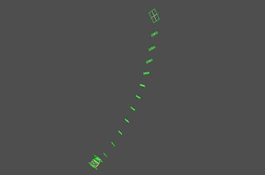 |
|
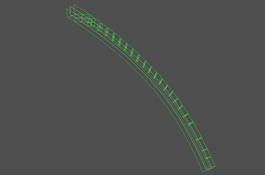 |
| Reflectors on the optical rail (year 1) |
|
Optical rail (year 1) |
The second year was then devoted to modeling facets on concave lenses and calculating their angle for optimal reflection of light to the eye. At the end of the path, the light was reflected twice at 90 ° to eventually be led to the retina!
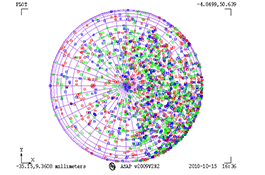 |
|
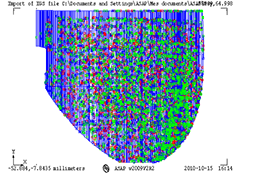 |
| Illumination of the eye with 20 prisms |
|
Illumination of the glass with 20 prisms |
| |
|
|
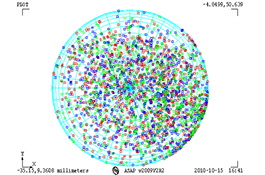 |
|
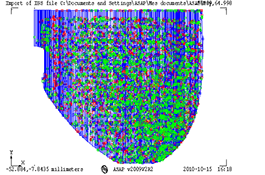 |
| Illumination of the eye with 30 prisms |
|
Illumination of the glass with 30 prisms |
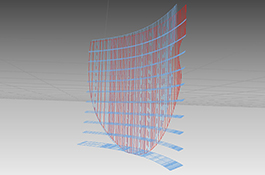 |
|
 |
3D view of the optimized glass
(year 2) |
|
Study of the illumination system eyeball |
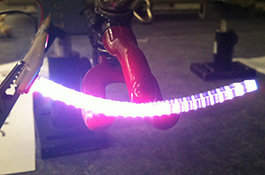 |
|
 |
| First rail (year 3) |
|
Final Rail |
It was thus compulsory to find a small but sufficiently powerful diode; in addition, the diode needn't melt the material in front of which it is positioned to illuminate the lens. Once this step was validated, it was necessary to develop a system that would allow the diffusion of the light of a single diode, via the optical rail, into the entire lens surface. Indeed, once the guide rail installed, the light was not diffused uniformly in the whole of the lens.
B. Second technological difficulty
The second technological difficulty which PSiO Technologies had to face and that also justified the taking of a worldwide patent was the homogeneous light distribution in the portion of the curved PSiO eye lens. Indeed, this technology did not exist as such. If the lenses had been straight, the development would have been relatively simple and equal light distribution easier,and would have been easier to achieve
But the designer wanted a device in the form of glasses which followed the contours of the face and that especially produced an effect of "infinite" depth which prevents the tuning of the pupil and without possible exposure of the user to external environment. Rectilinear lenses were therefore not part of the specification. Professor Habraken thought he could easily take up the challenge through two years of research. Unfortunately, after three years, results were disappointing.
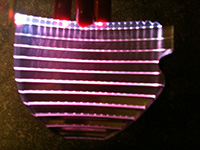 |
|
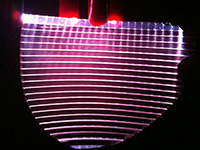 |
After first correction
(year 3) |
|
After second adjustment
(year 4) |
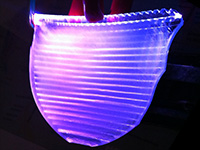 |
|
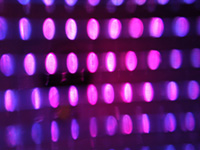 |
After the third adjustment
(year 4) |
|
Result for the eye (at a distant of
2 cm from the eye glass) |
Eventually, a world patent was taken and the final correction gave get the desired effect with a total homogeneity from a single diode mounted in front of a rail placed against the upper surface of the lens.
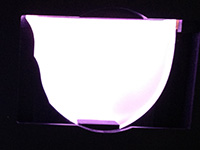 |
|
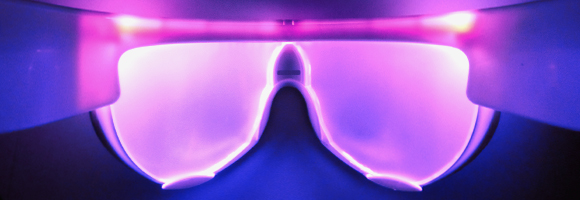 |
| Final result |
|
Final result in the glasses |
In total, five years of academic research were necessary to develop the PSiO, with persisting anxiety until the last six months of never being able to stick to the basic specifications !
To achieve this seemingly inaccessible result, it was compulsory to reach a surface roughness similar to that of the Hubble Space Telescope mirrors. Extreme precision mold optical quality required by a mold of such optical quality involved a long process of development with special tooling equipped with diamond tips and an approved environmental "clean room". With this ultimate precision, light could finallybe spread evenly on to the whole surface of the eye lens.
 |
| Hubble Space Telescope |
HIGH-TECH Production
Injection
The injection of an optical lens requires a dust free environment more secure than that of an operating room. Dusts are removed using specific filters and blowers. The people who work there must undress and put on overalls and a mask. A pressurized airlock allows access to the room where injection and preparation of the lenses is conducted.
Electronics production
The electronic mounting and assembly are done in another space which must also meet extreme quality standards in order not to alter the detailed work done upstream.
Final assembly
In the final area where final assembly is made, employees are still equipped with special outfits, gloves and anti-dust clogs like in modern hospitals.
Final result
The PSiO is the only "all in one" device of its kind in the world, that is to say which includes a rechargeable battery in the glasses arms and which allows open eyes stimulation in a limitless optical environment.
The PSiO is comfortable and weighs only 107 grams. It is now time for total relaxation to begin !
Download platform
During the optic R & D period of time, the partners were also active in the development of an online international download platform. Unfortunately, after the first attempt, everything had to be started up from scratch. It could eventually be finalized thanks to the intervention and entry into the company's capital of Mr. Thierry Pierson who is a specialist in online payments and ex -founder of Ogone, world leader in this sector.
Investment
Pure research and development of the PSiO lasted for five years with PSiO Technologies's full-time team and thirty collaborators involved. PSiO Technologies's capital had to be mounted up to USD 1.4 million. The Wallonia Region is also a partner who participated for a recoverable advance of USD 1.3 M. PSiO Technologies's reconstruction value of assets before marketing was valued at USD 5 million.
- Research in physical optics for equal light distribution
- Study for an optical injection molding and cleanroom
- Study of power consumption and development of a rechargeable battery
- Global Electronic Engineering
- Sound engineering
- Global prototyping
- Study of the molding of the frame
- Software development colorization
- Development of an international platform for multilingual, multicurrency and multi-card download
- Prototyping of PSiO lenses
Neuroscience
|
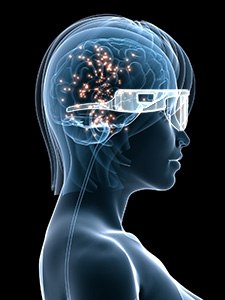 |
|
It should be noted that the PSiO R&D started in 2007with, as starting blocks, a content corresponding to 200 relaxation recordings and fifteen years of research and pre-developments in the field of psycho- acoustics, indirect suggestion and the influence of audio- visual rhythms of consciousness.
More on the "Research" page |
World Patent
Brands & global model
Domain names reserved
|